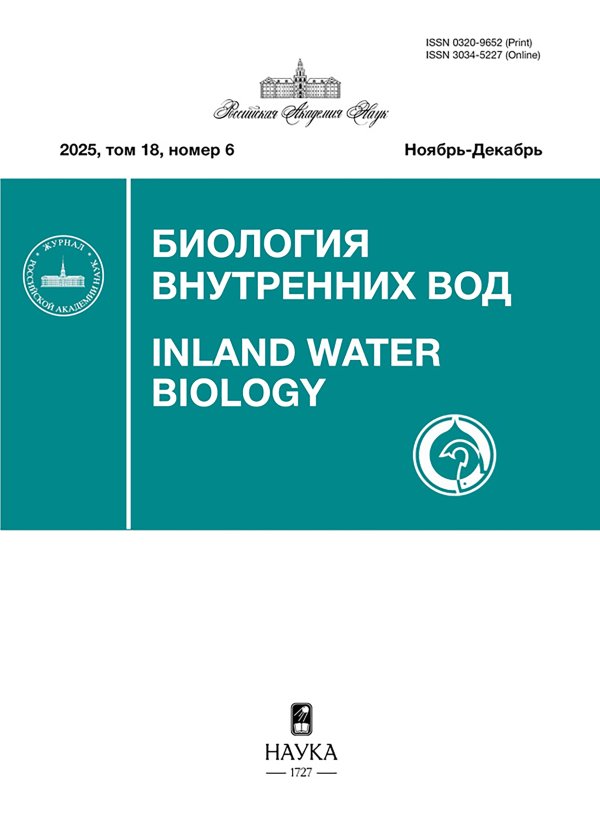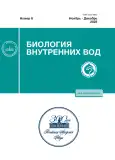Content of Pigments in the Bottom Sediments in a Small Valley–Channel Reservoir
- Authors: Sigareva L.E.1, Timofeeva N.A.1, Zakonnov V.V.1
-
Affiliations:
- Papanin Institute for Biology of Inland Waters, Russian Academy of Sciences
- Issue: No 6 (2023)
- Pages: 811-820
- Section: ФИТОПЛАНКТОН, ФИТОБЕНТОС, ФИТОПЕРИФИТОН
- URL: https://journals.rcsi.science/0320-9652/article/view/232383
- DOI: https://doi.org/10.31857/S032096522306030X
- EDN: https://elibrary.ru/LVEGKO
- ID: 232383
Cite item
Full Text
Abstract
This paper presents the first data on the content of plant pigments in the bottom sediments of the Uvod Re-servoir (Volga basin, Russia), unique in its hydrological regime, which support the hypothesis of more intensive carbon accumulation in small water bodies. It is established that the average concentration of chlorophyll a and its transformation products at the stations is 62.6 ± 10.0 μg/g dry sediment, 35.2 ± 4.5 mg/(m2 mm) of wet sediment, and 0.73 ± 0.09 mg/g organic matter of sediments. The ratio of organic carbon to the pigment concentration varies within 400–6000 depending on the type of bottom sediments, which significantly exceeds the values known for macrophytes and phytoplankton. Despite the features of hydrodynamics and geomorphology of the reservoir, the spatial distribution of sedimentary pigments is consistent with the structure of the bottom sediment complex, which is typical for water bodies of different types. A decrease in differences between the pigment concentrations in the sandy and silty biotopes of the Uvod Reservoir compared to the Upper Volga was noted. Average concentration of chlorophyll a with pheopigments (58.5 ± 6.7 μg/g of dry sediment), calculated considering the areas of bottom sediments of different types, in the Uvod Reservoir is 2.3 times higher than in the Gorky Reservoir (25.3 ± 1.5 μg/g), from which water inflows through the Volga–Uvod Canal. According to the content of sedimentary pigments, the trophic state of the reservoir is mesotrophic. Features of eutrophication in the Uvod Reservoir are more distinctly expressed than in the Gorky Re-servoir.
Keywords
About the authors
L. E. Sigareva
Papanin Institute for Biology of Inland Waters, Russian Academy of Sciences
Author for correspondence.
Email: sigareva@ibiw.ru
Russia, Nekouzskii raion, Yaroslavl oblast, Borok
N. A. Timofeeva
Papanin Institute for Biology of Inland Waters, Russian Academy of Sciences
Email: sigareva@ibiw.ru
Russia, Nekouzskii raion, Yaroslavl oblast, Borok
V. V. Zakonnov
Papanin Institute for Biology of Inland Waters, Russian Academy of Sciences
Email: sigareva@ibiw.ru
Russia, Nekouzskii raion, Yaroslavl oblast, Borok
References
- Авакян А.Б., Салтанкин В.П., Шарапов В.А. 1987. Водохранилища. М.: Мысль.
- Алимов А.Ф. 2000. Элементы теории функционирования водных экосистем. СПб.: Наука.
- Буторин Н.В., Зиминова Н.А., Курдин В.П. 1975. Донные отложения верхневолжских водохранилищ. Л.: Наука.
- Винберг Г.Г. 1960. Первичная продукция водоемов. Минск: Изд-во АН БССР.
- Долотов А.В., Гапеева М.В., Козловский Е.В. 2010. Оценка загрязнения тяжелыми металлами Уводьского водохранилища // Вод. ресурсы. 2010. Т. 37. № 1. С. 58.
- Жукова Т.В., Михеева Т.М., Адамович Б.В. и др. 2016. Бюллетень экологического состояния озер Нарочь, Мястро, Баторино (2015 год). Минск: Белорус. гос. ун-т.
- Законнов В.В. 2007. Осадкообразование в водохранилищах волжского каскада: Автореф. дис. … докт. геогр. наук. М.: ИГ РАН. 39 с.
- Законнов В.В., Куражковский А.Ю., Маркевич Г.И. 2000. Экология Уводьского водохранилища. Донные отложения и особенности их формирования // Экология, биоразнообразие и систематика водных беспозвоночных. Ч. 2. Борок. С. 279. Деп. в ВИНИТИ. 17.01.2000, № 73-В00.
- Ковалева И.В., Финенко З.З. 2019. Количественные закономерности изменения относительного содержания хлорофилла при совместном действии света и температуры у диатомовых водорослей // Вопросы современной альгологии. № 3(21). С. 28.
- Маркевич Г.И., Елизарова В.А. 2000. Экология Уводьского водохранилища. Фитопланктон и фотосинтетические пигменты // Экология, биоразнообразие и систематика водных беспозвоночных. Ч. 2. Борок. С. 170. Деп. в ВИНИТИ. 17.01.2000, № 73-В00.
- Минеева Н.М. 2004. Растительные пигменты в воде волжских водохранилищ. М.: Наука.
- Папченков В.Г., Маркевич Г.И. 2003. Флора и растительность Уводьского водохранилища // Биология внутр. вод. № 4. С. 18.
- Румянцев В.А., Коронкевич Н.И., Измайлова А.В. и др. 2021. Водные ресурсы рек и водоемов России и антропогенные воздействия на них // Изв. РАН. Сер. геогр. Т. 85. № 1. С. 120.
- Сигарева Л.Е., Тимофеева Н.А. 2001. Растительные пигменты в донных отложениях как показатели трофического состояния водохранилищ Верхней Волги // Проблемы региональной экологии. № 2. С. 23.
- Сигарева Л.Е., Тимофеева Н.А. 2023. Пигментные характеристики макрофитов Рыбинского водохранилища // Биология внутр. вод. № 3. С. 420.https://doi.org/10.31857/S0320965223030233
- Сигарева Л.Е., Тимофеева Н.А., Законнов В.В. 2004. Особенности распределения растительных пигментов в донных отложениях Чебоксарского водохранилища // Гидробиол. журнал. Т. 40. № 5. С. 27.
- Сигарева Л.Е., Тимофеева Н.А., Законнов В.В. 2013. Оценка влияния фитопланктона на продукционные свойства донных отложений Чебоксарского водохранилища по растительным пигментам // Вода: химия и экология. № 1. С. 72.
- Сигарева Л.Е., Тимофеева Н.А., Законнов В.В. 2022. Растительные пигменты и органическое вещество в донных отложениях крупных мелководных озер Северо-Запада России // Геохимия. Т. 67. № 12. С. 1284.
- Смольская О.С., Жукова А.А. 2020. Содержание растительных пигментов в донных отложениях озер Нарочь, Мястро и Баторино // Журн. Белорус. гос. ун-та. Экология. № 2. С. 18.
- Соловьева В.В. 1996. Фитопланктон Уводьского водохранилища // Эколого-физиологические исследования водорослей и их значение для оценки состояния природных вод. Ярославль: Ярослав. гос.-техн. ун-т. С. 95.
- Структура и функционирование экосистемы Рыбинского водохранилища в начале XXI века. 2018. М.: РАН.
- Тимофеева Н.А., Сигарева Л.Е., Законнов В.В. 2021. Вариабельность трофии донных биотопов Горьковского водохранилища по осадочным пигментам // Вод. ресурсы. Т. 48. № 1. С. 70.
- Тищенко П.Я., Медведев Е.В., Барабанщиков Ю.А. и др. 2020. Органический углерод и карбонатная система в донных отложениях мелководных бухт залива Петра Великого (Японское море) // Геохимия. Т. 65. № 6. С. 583.
- Behrenfeld M.J., Boss E., Siegel D.A., Shea D.M. 2005. Carbon-based ocean productivity and phytoplankton physiology from space // Glob. Biogeochem. Cycles. V. 19. № 1. GB1006. https://doi.org/10.1029/2004GB002299
- Bernát G., Boross N., Somogyi B. et al. 2020. Oligotrophication of Lake Balaton over a 20-year period and its implications for the relationship between phytoplankton and zooplankton biomass // Hydrobiologia. V. 847. № 19. P. 3999. https://doi.org/10.1007/s10750-020-04384-x
- Cabecinha E., Van den Brink P.J., Cabral J.A. et al. 2009. Ecological relationships between phytoplankton communities and different spatial scales in European reservoirs: implications at catchment level monitoring programmes // Hydrobiologia. V. 628. № 1. P. 27. https://doi.org/10.1007/s10750-009-9731-y
- Cardoso-Silva S., Mizael J.O.S.S., Frascareli D. et al. 2022. Geochemistry and sedimentary photopigments as proxies to reconstruct past environmental changes in a subtropical reservoir // Environ. Sci. Pollut. Res. V. 29. № 19. P. 28495. https://doi.org/10.1007/s11356-022-18518-2
- Fisher J.B., Lick W.J., McCall P.L., Robbins J.A. 1980.Vertical mixing of lake sediments by tubificid oligochaetes // J. Geophys. Res. V. 85. № C7. P. 3997.
- Garnier M., Holman I. 2019. Critical review of adaptation measures to reduce the vulnerability of European drinking water resources to the pressures of climate change // Environ. Man. V. 64. № 2. P. 138. https://doi.org/10.1007/s00267-019-01184-5
- Gushulak C.A., Leavitt P.R., Cumming B.F. 2021. Basin-specific records of lake oligotrophication during the middle-to-late Holocene in boreal northeast Ontario, Ca-nada // The Holocene. V. 31. № 10. P. 1539. https://doi.org/10.1177/09596836211025972
- Hofmann A.M., Kuefner W., Mayr C. et al. 2021. Unravelling climate change impacts from other anthropogenic influences in a subalpine lake: a multi-proxy sediment study from Oberer Soiernsee (Northern Alps, Germany) // Hydrobiologia. V. 848. № 18. P. 4285. https://doi.org/10.1007/s10750-021-04640-8
- Krol M.S., de Vries M.J., van Oel P.R., de Araújo J.C. 2011. Sustainability of small reservoirs and large scale water availability under current conditions and climate change // Water Resour. Man. V. 25. № 12. P. 3017. https://doi.org/10.1007/s11269-011-9787-0
- Lorenzen C.J. 1967. Determination of chlorophyll and phaeo-pigments: spectrophotometric equations // Limnol., Oceanogr. V. 12. № 2. P. 343. https://doi.org/10.4319/lo.1967.12.2.0343
- Makri S., Lami A., Lods-Crozet B. et al. 2019. Reconstruction of trophic state shifts over the past 90 years in a eutrophicated lake in western Switzerland, inferred from the sedimentary record of photosynthetic pigments // J. Paleolimnol. V. 61. № 2. P. 129. https://doi.org/10.1007/s10933-018-0049-5
- Moir K.E., Hickey M.B.C., Leavitt P.R. et al. 2018. Paleolimnological proxies reveal continued eutrophication issues in the St. Lawrence River Area of Concern // J. Great Lakes Res. V. 44. P. 357. https://doi.org/10.1016/j.jglr.2018.02.001
- Möller W.A.A., Scharf B.W. 1986. The content of chlorophyll in the sediment of the volcanic maar lakes in the Eifel region (Germany) as an indicator for eutrophication // Hydrobiologia. V. 143. № 1. P. 327. https://doi.org/10.1007/BF00026678
- Phillips G., Pietiläinen O.P., Carvalho L. et al. 2008. Chlorophyll-nutrient relationships of different lake types using a large European dataset // Aquat. Ecol. V. 42. № 2. P. 213. https://doi.org/10.1007/s10452-008-9180-0
- Post D., Pace M., Hairston N. 2000. Ecosystem size determines food-chain length in lakes // Nature. V. 405. P. 1047. https://doi.org/10.1038/35016565
- Rahaman M., Masroor M., Rehman S. et al. 2022. State of art of review on climate variability and water resources: bridging knowledge gaps and the way forward // Water. Res. V. 49. № 4. P. 699. https://doi.org/10.1134/S0097807822040169
- Rühland K.M., Paterson A.M., Smol J.P. 2015. Lake diatom responses to warming: reviewing the evidence // J. Paleolimnol. V. 54. № 1. P. 1. https://doi.org/10.1007/s10933-015-9837-3
- Swain E.B. 1985. Measurement and interpretation of sedimentary pigments // Freshwater Biol. V. 15. № 1. P. 53. https://doi.org/10.1111/j.1365-2427.1985.tb00696.x
- Winslow L.A., Read J.S., Hanson P.C., Stanley E.H. 2015. Does lake size matter? Combining morphology and process modeling to examine the contribution of lake classes to population-scale processes // Inland Waters. V. 5. № 1. P. 7. https://doi.org/10.5268/IW-5.1.740
- Wu Q., Li Q., Luo H. et al. 2022. Comparison in phytoplankton diversity-productivity-community stability between river-type reservoir and lake-type reservoir // J. Ocean. Limnol. V. 40. № 4. P. 1485. https://doi.org/10.1007/s00343-021-1175-x
Supplementary files













